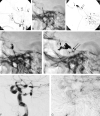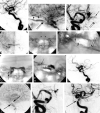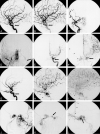Transvenous n-butyl-cyanoacrylate infusion for complex dural carotid cavernous fistulas: technical considerations and clinical outcome
- PMID: 16155130
- PMCID: PMC8148853
Transvenous n-butyl-cyanoacrylate infusion for complex dural carotid cavernous fistulas: technical considerations and clinical outcome
Abstract
Background and purpose: Endovascular transvenous embolization has been advocated as the treatment technique for dural carotid cavernous fistulas (dCCFs). Most centers use platinum coils primarily. The purpose of this study was to evaluate the technical aspects, efficacy, and safety of transvenous n-butyl cyanoacrylate (n-BCA) infusion in dCCFs as a primary alternative or adjunct to coil embolization.
Methods: We retrospectively evaluated 14 patients with dCCFs who were treated at this institution from 1999 to 2004 by using n-BCA infusion alone or in combination with coils. The efficacy of treatment and safety aspects were studied in dCCFs of Barrow type B (4/14), C (2/14), and D (8/14). Six patients were treated with transvenous n-BCA infusion alone in the cavernous sinus, 7 with a combination of transvenous n-BCA and coil embolization, and one with transvenous n-BCA combined with transarterial polyvinyl alcohol (PVA)-particle embolization of the feeding arteries.
Results: An angiographic obliteration and clinical cure was achieved in all patients. Technical complications were nonsymptomatic and included spillage of an n-BCA droplet into a middle cerebral artery branch retrograde through the arteriovenous fistulas in one patient and perforation of the inferior petrosal sinus during microcatheter placement in another. A third patient developed temporary palsy of the sixth cranial nerve a few days after the treatment.
Conclusion: In this small series, the use of n-BCA either alone or in conjunction with detachable coils was a safe and effective technique for the treatment of symptomatic patients presenting with complex dCCFs.
Figures





References
-
- Newton TH, Cronqvist S. Involvement of dural arteries in intracranial arteriovenous malformations. Radiology 1969;93:1071–1078 - PubMed
-
- Barrow DL, Spector RH, Braun IF, et al. Classification and treatment of spontaneous carotid-cavernous fistulas. J Neurosurg 1985;62:248–256 - PubMed
-
- Kwan E, Hieshima GB, Higashida RT, et al. Interventional neuroradiology in neuro-ophthalmology. J Clin Neuroophthalmol 1989;9:83–97 - PubMed
-
- Nukui H, Shibasaki T, Kaneko M, et al. Long-term observations in cases with spontaneous carotid-cavernous fistulas. Surg Neurol 1984;21:543–552 - PubMed
Publication types
MeSH terms
Substances
LinkOut - more resources
Full Text Sources
Miscellaneous
